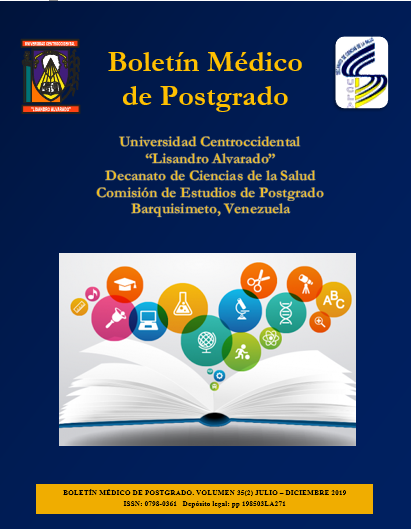Clinical and epidemiological characteristics of Recurrent Respiratory Papillomatosis in pediatric patients
Keywords:
clinical characteristics, epidemiological, recurrent respiratory papillomatosis, pediatric ageAbstract
Recurrent respiratory papillomatosis (RRP) is the second most frequent cause of dysphonia during childhood; the most frequent causative agent is human papillomavirus serotypes 6 and 11. In order to describe the clinical and epidemiological characteristics of RRP In pediatric admitted to the Servicio Desconcentrado Hospital Pediátrico Dr. Agustín Zubillaga, a cross-sectional descriptive study was conducted during the 2011-2016 period. The average age of diagnosis was 4.4 ± 2.41 years, with the highest prevalence in preschool children (70%) and with no sex predilection. 90% of patients were product of vaginal delivery and 30% reported asthma and low respiratory infection. The clinical features present were dysphonia (90%), dyspnea (70%) and stridor (60%); location of the lesions were anterior commissure (100%), vocal folds (80% right and 90% left) and vestibule (40%). 40% of patients reported HPV-6 and 10% HPV-11. Treatment was surgical in 100% of cases of which 50% required a second pruning and 30% three pruning; 10% needed a tracheotomy. This study provides information on the importance of early recognition of persistent dysphonia allowing to reduce diagnosis delay of RRP and facilitate timely management with lower rates of long-term recurrence.
Downloads
References
2. Rodríguez V, Michalski D. Papilomatosis laríngea infantil. Rev. FASO 2010; 17(2): 16-22.
3. Ávila E, Naranjo V. (2018). Incidencia y recurrencia de Papilomatosis Laríngea en pacientes que acuden por consulta externa al servicio de otorrinolaringología en el Hospital de Especialidades Teodoro Maldonado Carbo desde enero de 2012 hasta enero 2017, Guayaquil, Ecuador. Trabajo de titulación previo a la obtención del título de Médico. Universidad Católica de Santiago de Guayaquil, Ecuador.
4. Werth L, Rowley S, De la Guardia A. Papilomatosis Respiratoria Recurrente: Un Resumen de los Casos Pediátricos de Panamá de 2003-2013. Pediátr. Panamá 2014; 43(1): 23-30.
5. Cuestas G, Rodríguez V, Doormann F, Bellia P, Bellia G. Papilomatosis laríngea: una causa poco frecuente de disfonía en el niño. Serie de casos. Arch. Argent. Pediatr 2018; 116(3): e471-e475.
6. Larson D, Derkay C. Epidemiology of recurrent respiratory papillomatosis. APMIS 2010; 118(6-7): 450-4.
7. Fita A, Díaz J, Reyes S, Pastor P, Navarro A. Disfonía infantil precoz como síntoma de alerta de la papilomatosis laríngea juvenil. Anales de Pediatría 2015; 83(3): 147-226.
8. Castillo H, Caro V, González M, Acosta L, Correnti M, Suárez J. Papilomatosis laríngea juvenil y su relación con la infección genital por virus de papiloma humano durante el embarazo. Rev Obstet Ginecol Venez 2015; 75(4): 260-268.
9. Monnier P. (2011). Recurrent respiratory papillomatosis. En: Monnier, P. ed. Pediatric airway surgery. Management of laryngotracheal stenosis in infants and children. Berlin, Heidelberg.
10. Lugo J, Saínz N, González R, Sánchez M, Mendoza V, Pineda A. Papilomatosis respiratoria recurrente: análisis del impacto económico en el tratamiento quirúrgico. Horiz Med 2017; 17(4): 30-34.
11. Silva L, Gonçalves C, Fernandes A. Laryngeal papillomatosis in children: The impact of late recognition over evolution. J Med Virol 2015; 87(8): 1413-7.
12. Rodríguez H, Cuestas G, Álvarez M, Monaje M. Papilomatosis respiratoria recurrente con compromiso pulmonar y de la pared torácica: una rara complicación en un adolescente. Acta Otorrinolaringol Esp 2018; 69(2): 110-113.
13. Luong T, Scrigni A, Ruvinsky S, Cocciaglia A, Rowensztein H. (2015). Papilomatosis respiratoria recurrente. Caso clínico. Arch Argent Pediatr 2015; 113(4): e203-e206.
14. Carifi M, Napolitano D, Morandi M, Dall’Olio D. Recurrent respiratory papillomatosis: current and future perspectives. Ther Clin Risk Manag 2015; 11: 731-8.
15. Immunization Practices. Rev. Centers for disease control y prevention, MMWR. 2015. Vol. 64.
Published
How to Cite
Issue
Section
Las opiniones expresadas por los autores no necesariamente reflejan la postura del editor de la publicación ni de la UCLA. Se autoriza la reproducción total o parcial de los textos aquí publicados, siempre y cuando se cite la fuente completa y la dirección electrónica de esta revista. Los autores(as) tienen el derecho de utilizar sus artículos para cualquier propósito siempre y cuando se realice sin fines de lucro. Los autores(as) pueden publicar en internet o cualquier otro medio la versión final aprobada de su trabajo, luego que esta ha sido publicada en esta revista.



